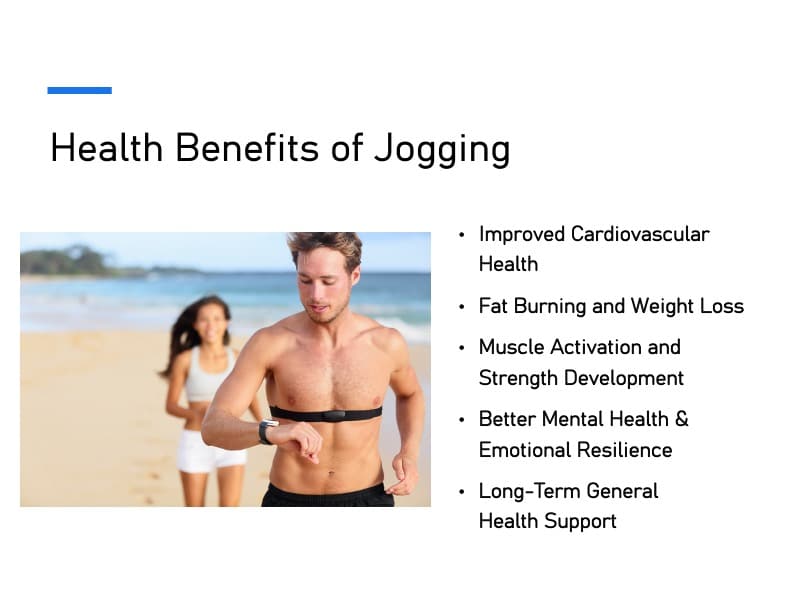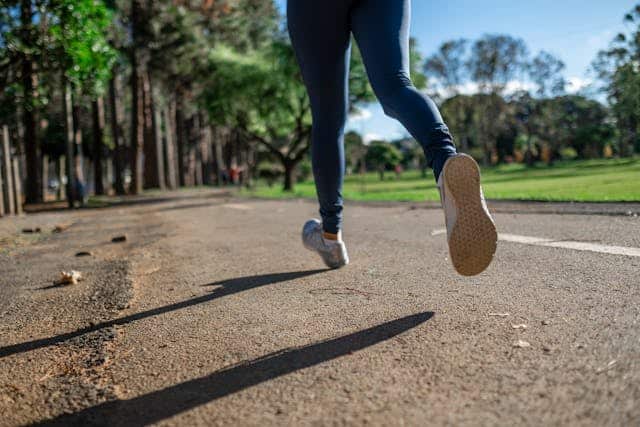Health Benefits of Jogging: Is Jogging Good for You?
Jogging is one of the most accessible and time-tested forms of cardiovascular exercise, offering a wide range of physical and mental benefits for nearly every fitness level.
In an era of high-tech workout programs, expensive boutique fitness classes, and complex training devices, jogging stands out for its simplicity and its proven effectiveness.
As a professional athlete, I’ll be honest: jogging has never been my favorite form of exercise.
I prefer walking for daily movement, sprint workouts for explosiveness, and strength training for performance.
But even with that preference, I fully recognize the immense value of jogging, especially when it comes to building an aerobic foundation.
Over the years, I’ve turned to jogging during off-season and recovery phases to rebuild endurance, stay lean, and support overall health.
Jogging isn’t flashy, but that’s part of its power.
It’s a low-barrier, self-paced activity that helps improve cardiovascular fitness, burn fat, and get fit without going to the gym or developing a complicated routine.
Whether you’re looking to improve your health, manage stress, or start a sustainable fitness habit, jogging remains one of the most effective tools available.
What Is Jogging?

Jogging is a simple form of steady-state aerobic exercise that involves running at a moderate, sustainable pace, typically slower than 6 miles per hour.
As a low-impact alternative to high-speed running, jogging is ideal for elevating heart rate without pushing the body to maximum intensity, building cardiovascular endurance, improving overall aerobic capacity, and burning calories over time.
Among cardio workouts, jogging is known for its simplicity and accessibility, requiring little more than a good pair of shoes and a safe path or treadmill.
Jogging vs Running: What’s the Difference?
While both running and jogging use the same movement mechanics, the key difference is the intensity and impact on the body.
Jogging places less strain on your joints and muscles than high-speed running. It’s ideal for longer sessions and more frequent outings, making it more sustainable for weight loss, general health, and mental clarity.
Running, on the other hand, is usually faster, more intense, and places greater stress on the body.
While it can be more effective for building speed or increasing VO₂ max in shorter durations, it may also carry a higher injury risk if overdone.
What Muscles Does Jogging Work?
Jogging primarily works the muscles of the lower body and core.
- The gluteus maximus powers hip extension, especially during the push-off phase.
- The quadriceps control knee extension and help absorb impact during landing, while the hamstrings assist in hip extension and knee flexion.
- The calf muscles, especially the gastrocnemius and soleus, drive plantar flexion as you push off the ground.
- Hip flexors are engaged during the swing phase of each stride, and the core muscles (including the rectus abdominis, obliques, and transverse abdominis) help stabilize the torso and pelvis.
- The erector spinae also assist with posture and spinal alignment, especially during longer runs.
Though jogging is a lower-intensity exercise, the repeated activation of these muscle groups improves endurance, coordination, and overall running economy.
Evidence-Based Health Benefits of Jogging

Jogging may seem simple, but its impact on the body is anything but basic.
Backed by decades of research, jogging has been shown to improve nearly every system in the body, from heart and lung function to brain health, metabolism, and even immune response.
While it doesn’t require high-intensity or complex equipment, jogging delivers measurable, science-supported benefits that contribute to both short-term fitness and long-term health.
Whether you’re just starting out or returning after a break, understanding the evidence behind jogging’s benefits can help you stay motivated and build a smarter, more purposeful routine.
Improved Cardiovascular Health
Jogging improves your cardiorespiratory endurance, which is one of the most important indicators of long-term health and disease prevention. It strengthens the heart muscle, improves circulation, and increases oxygen efficiency.
A study published in the Journal of the American College of Cardiology concluded that even low-volume jogging (5-10 minutes per day) is associated with a reduced risk of cardiovascular disease and all-cause mortality (Lee et al., 2014).
The consistent, rhythmic nature of jogging trains your heart to become more efficient at pumping blood, helping lower your resting heart rate and blood pressure over time.
Fat Burning and Weight Loss
Jogging is good for weight loss and an effective tool for fat-burning and sustainable weight loss because it activates the aerobic energy system, which uses stored fat as a primary fuel source.
It’s especially useful for reducing visceral fat, the dangerous fat stored around internal organs, which is closely linked to metabolic diseases.
Research shows that regular aerobic exercise, such as jogging, can significantly lower total body fat, even without major dietary changes (Bellicha et al., 2021).
On average, jogging burns about 100–120 calories per mile, depending on your body weight and pace.
A 160-pound person, for example, will burn roughly 300–350 calories during a 30-minute jog at 5 mph.
This caloric expenditure contributes directly to the energy deficit required for fat loss.
Although you can’t spot-reduce fat, jogging consistently can help trim belly fat by reducing overall body fat percentage and improving insulin sensitivity and cortisol regulation, two factors closely tied to abdominal fat storage.
Jogging also improves metabolic function, increases post-exercise calorie burn, and improves appetite regulation, making it a powerful long-term strategy for weight management.
Compared to walking, jogging burns more calories in less time and stimulates greater aerobic adaptations.
While walking is ideal for beginners or those with joint concerns, jogging offers more efficient fat loss and greater cardiovascular improvements when performed regularly and safely.
Muscle Activation and Strength Development
Jogging engages a wide range of muscles, particularly in the lower body, including the glutes, quadriceps, hamstrings, calves, and hip flexors, while also activating the core muscles to stabilize the spine and pelvis with each stride.
Although it doesn’t build muscle mass like resistance training, jogging enhances muscular endurance, coordination, and neuromuscular efficiency.
These adaptations improve posture, joint stability, and functional strength, making everyday movements more efficient and reducing injury risk during other physical activities.
Over time, regular jogging can also help maintain lean muscle tissue, especially when combined with proper nutrition and strength training.
Better Mental Health & Emotional Resilience
One of jogging’s most profound yet underrated effects is on mental well-being.
Jogging is a natural remedy for stress that promotes the release of endorphins and other mood-enhancing neurotransmitters such as serotonin and dopamine.
This creates what many describe as a “runner’s high”—a feeling of clarity, reduced anxiety, and improved mood.
Studies show that aerobic exercise, like jogging, is comparable to antidepressant medication in treating mild-to-moderate depression (Blumenthal et al., 2007).
The meditative rhythm, exposure to nature, and sense of accomplishment from jogging all combine to support emotional resilience and lower daily stress levels.
Long-Term General Health Support
Jogging supports metabolic health, blood sugar regulation, and anti-aging mechanisms.
Moderate aerobic exercise like jogging helps maintain mitochondrial efficiency, which declines with age.
It also improves insulin sensitivity, helping the body better process glucose.
Regular jogging reduces triglycerides, LDL cholesterol, and chronic inflammation, which are factors strongly linked to metabolic syndrome and heart disease risk (Kodama et al., 2007).
Safety Tips – How to Jog Safely
Jogging offers tremendous physical and mental benefits, but poor technique or lack of preparation can quickly lead to overuse injuries, joint stress, or long-term setbacks.
To keep jogging safe and sustainable, it’s essential to warm up with dynamic stretches like leg swings and hip circles, wear well-fitted running shoes that match your foot type, and increase your weekly mileage gradually at no more than 10% per week.
Prioritize recovery by including rest days and sleep, and opt for softer surfaces like grass or trails when possible to reduce joint impact.
Maintain good form by running tall, keeping your arms relaxed, landing mid-foot, and avoiding overstriding.
Pay attention to warning signs like joint pain or persistent soreness, and don’t ignore them.
Incorporating strength training for your glutes, calves, and core a few times per week will also improve durability.
Stay hydrated, fuel your body properly before and after jogging, and finish with a cooldown walk and static stretching to enhance recovery and flexibility.
With consistent care and smart programming, jogging can remain a lifelong tool for health and performance.

How to Start Jogging (A Beginner’s Guide)
Starting a jogging routine can feel intimidating, but it doesn’t need to be. Here’s how to build consistency and reduce injury risk:
Start with Intervals
Begin with a walk-jog protocol.
- For example, jog for 1 minute and walk for 2 minutes.
- Repeat for 20–30 minutes.
- Gradually increase your jogging time over a few weeks.
Jog for Time, Not Distance
Focus on staying consistent rather than hitting a mileage goal.
Jog for 10–20 minutes and increase as your aerobic capacity improves.
Focus on Form and Breathing
Run tall, land softly, and maintain a steady cadence.
Breathe through your nose or use a 3:2 inhale-to-exhale rhythm to regulate oxygen intake.
Pros and Cons of Jogging

Jogging is a low-barrier, high-impact activity when it comes to improving physical and mental health.
However, like any form of exercise, it comes with both advantages and limitations depending on your body, goals, and lifestyle.
The key is balancing it with strength training, mobility work, and adequate rest to avoid overuse and keep your body resilient.
Pros of Jogging
- Improves Cardiovascular Health: Jogging strengthens the heart, lowers resting heart rate, and improves blood flow, reducing the risk of cardiovascular disease (Lee et al., 2014).
- Supports Fat Loss & Weight Management: Jogging helps create a calorie deficit and supports fat oxidation, making it a reliable tool for sustainable weight loss.
- Boosts Mental Well-being: Regular jogging is associated with reduced symptoms of anxiety, depression, and stress through the release of endorphins and improved brain chemistry (Blumenthal et al., 2007).
- Accessible & Inexpensive: No gym membership or equipment is needed—just a good pair of running shoes. It’s one of the most affordable ways to stay active.
- Increases Aerobic Capacity and Endurance: Jogging trains your aerobic energy system, improving stamina, mitochondrial density, and lung function over time.
- Builds Routine & Discipline: Jogging is easy to build into a daily or weekly routine, offering a consistent way to improve fitness and develop discipline.
Cons of Jogging
- Repetitive Impact Stress: Over time, especially without proper footwear or recovery, jogging can lead to overuse injuries like shin splints, runner’s knee, or IT band syndrome.
- Doesn’t Maximize Muscle Growth: Jogging improves muscular endurance but doesn’t build muscle mass or strength the way resistance training does.
- Can Be Hard on Joints for Some: Individuals with joint issues, especially in the knees, hips, or lower back, may find jogging uncomfortable or risky without modifications.
- Plateaus Can Occur: Without progression (intensity, speed, or distance), the body can adapt to jogging, leading to stagnation in fat loss or fitness gains.
- May Not Suit Every Personality: Jogging can be monotonous for those who prefer high-intensity, competitive, or more dynamic forms of exercise.
Jogging vs. Sprinting: Which Is Better?
Both jogging and sprinting offer valuable health and fitness benefits, but they serve very different purposes within a training program.
Choosing between the two depends on your goals, like whether you’re aiming to burn fat, build muscle, increase endurance, or improve overall athletic performance.
Understanding the physiological differences between jogging and sprinting can help you determine which is better suited to your body, fitness level, and long-term objectives.
| Goal | Better Option |
|---|---|
| Fat Burning | Jogging (more sustained fat oxidation) |
| Muscle Growth | Sprinting (stimulates Type II fibers) |
| Cardiovascular Endurance | Jogging |
| Metabolic Boost | Sprinting (higher EPOC) |
| Injury Risk | Jogging (lower intensity) |
Sprinting is great for improving anaerobic capacity and speed, but it also places more strain on tendons and joints.
For general health and longevity, jogging provides a lower-risk path to fitness.
How to Make Jogging a Lifelong Habit
To make jogging a lifelong habit, start by investing in proper footwear and replacing your shoes every 300–500 miles to maintain support and reduce injury risk.
Always include a warm-up and cool-down to prepare your body and aid recovery.
Tracking your runs with a smartwatch or app can help monitor progress and keep you motivated.
Vary your routine by alternating intensities, such as easy jogs, tempo runs, or hill sessions, to avoid plateaus and keep things engaging.
Listening to music or podcasts can make your jogs more enjoyable, and joining a running group adds accountability, social support, and fun to the experience.
Final Thoughts: Is Jogging Good for You?

Jogging is one of the most effective and accessible forms of exercise for improving physical and mental health.
It supports cardiovascular fitness, burns fat, builds muscular endurance, and enhances emotional well-being, all without requiring a gym or expensive equipment.
Whether your goal is to lose weight, manage stress, or build a consistent fitness habit, jogging can be adapted to fit nearly any lifestyle or fitness level.
When done with proper form, recovery, and progression, jogging becomes more than just a workout, it becomes a lifelong tool for staying strong, healthy, and resilient.



